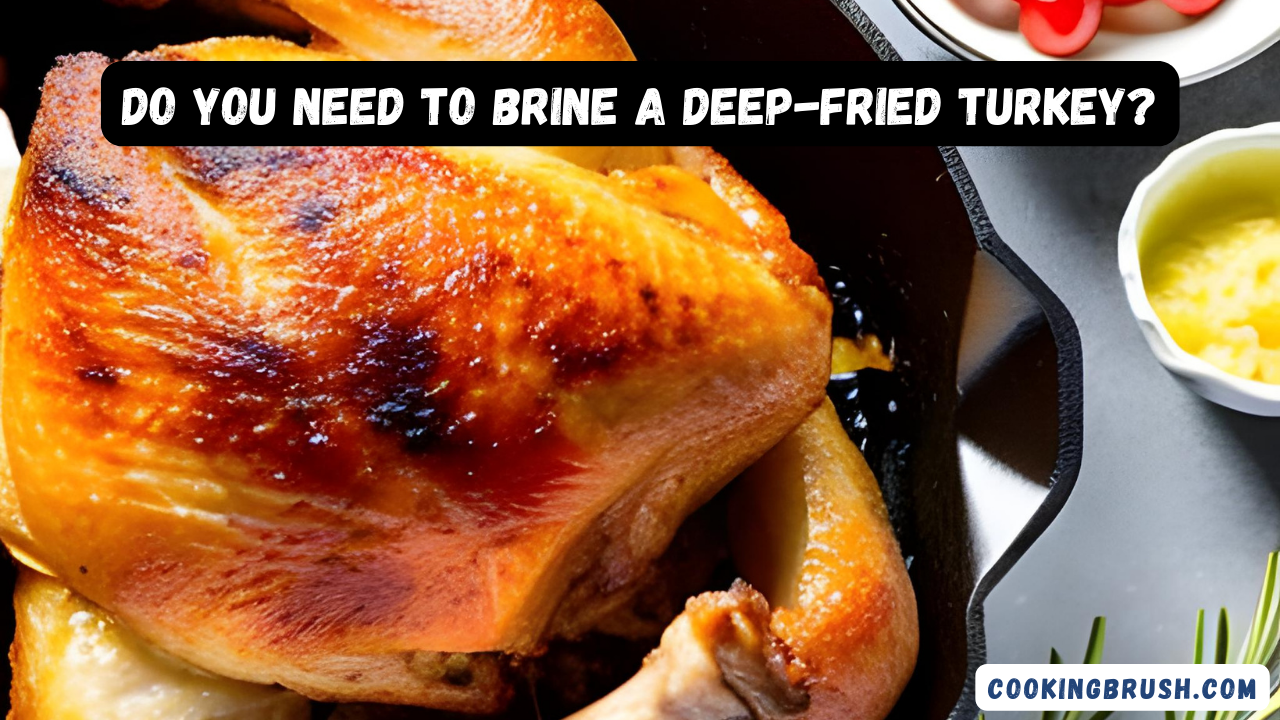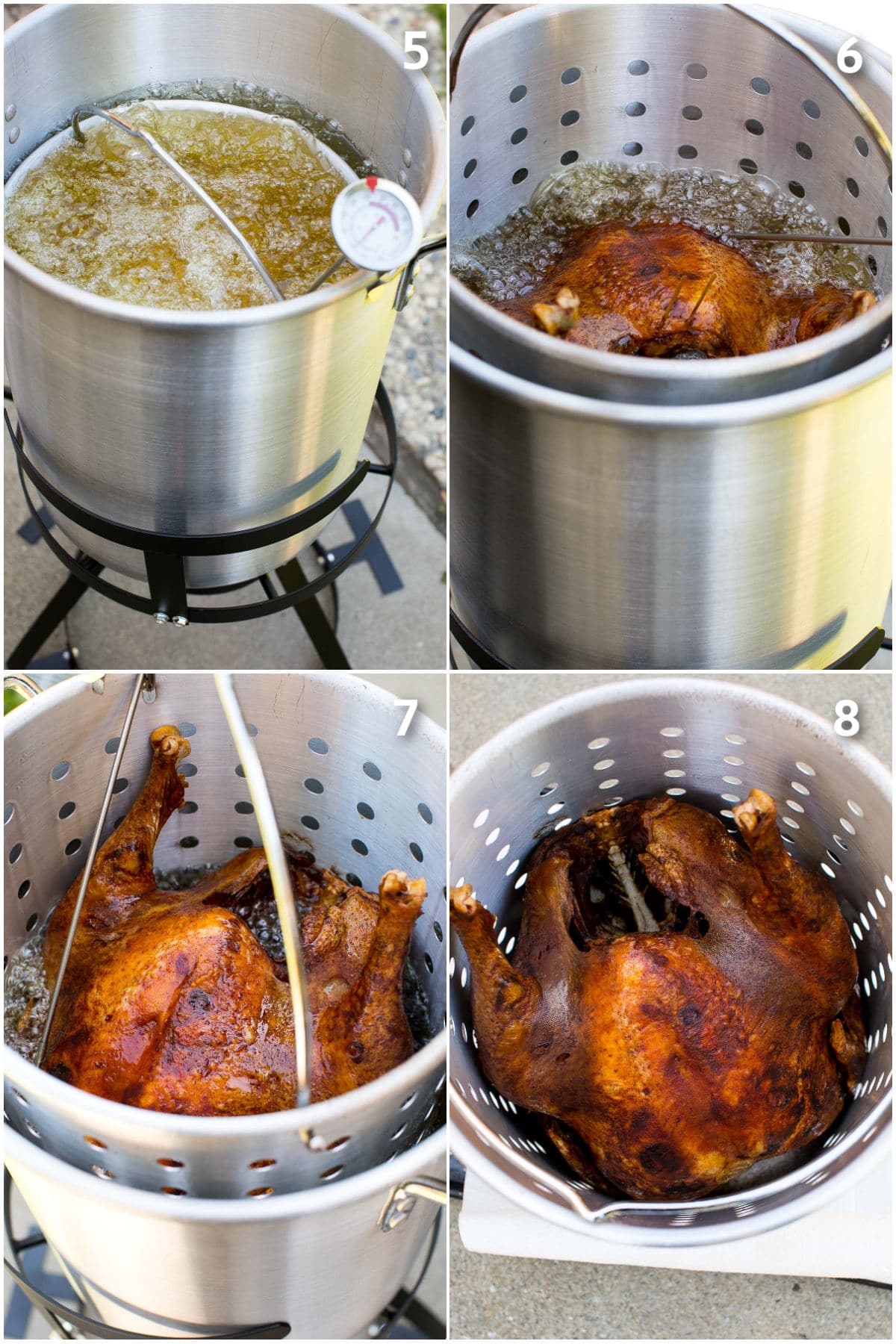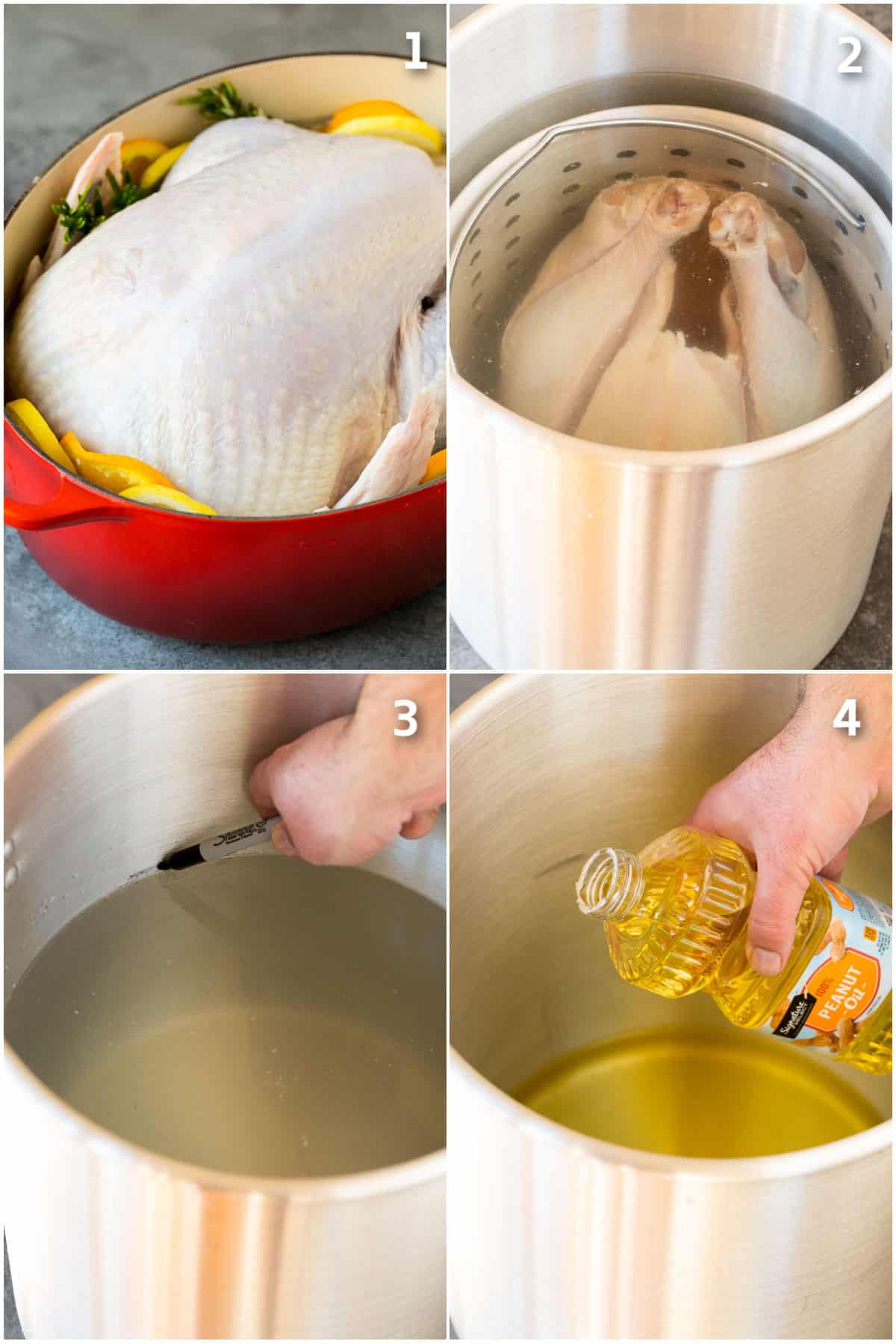This deep fried turkey is brined in a mixture of herbs and citrus, then fried to golden brown perfection. Fried turkey is crispy on the outside, and juicy and tender on the inside. The best way to prepare your holiday meal when you’re short on oven space!
Looking for something a little different to serve at Thanksgiving this year? Try a fried turkey, along with homemade cranberry sauce, sweet potato casserole, corn pudding and green beans almondine, for a memorable meal that will earn you rave reviews.
I always find myself running out of oven space when I’m making a big meal. I decided to try frying my turkey instead of roasting it, and the results were fantastic. Deep fried turkey cooks in a fraction of the time and the flavor just can’t be beat!
Fried turkey has become a popular alternative to traditional roasted turkey especially around the holidays. The crispy skin and moist juicy meat make fried turkey an irresistible treat. But does brining make sense when deep frying a turkey? Let’s take a closer look.
Why Brine a Turkey?
Brining is the process of soaking meat in a saltwater solution before cooking This serves several purposes
-
It seasons the meat throughout. The brine will penetrate deep into the turkey to add flavor.
-
It keeps the meat juicy The salt allows the turkey to retain more moisture during cooking
-
It improves texture. Brining allows the proteins in the meat to hold on to more water, preventing them from getting too tough.
A good brine for roasted or smoked turkey will include salt, sugar, and aromatics like garlic, spices, or herbs. The salt and sugar both help the turkey retain moisture.
So brining provides some clear benefits when roasting or smoking a turkey. But how does it impact a deep fried turkey?
Does Frying Change the Brining Equation?
Deep frying cooks food very quickly through full immersion in hot oil. This rapid cooking at high temperatures produces several effects:
-
Very fast browning and crisping of the exterior
-
Quick cooking of the interior, preventing it from drying out
-
Moist and juicy meat when done properly
Because a fried turkey cooks so fast, there is not as much time for the interior moisture to be lost. So fried turkeys tend to turn out juicy even without brining.
The high heat also leads to changes in texture – the meat can become almost moltenly tender. Brining may therefore have a more subtle impact on the final texture.
Potential Benefits of Brining Before Frying
While brining may not be as essential for fried turkey, it can still provide some advantages:
-
Enhanced flavor – The brine will penetrate the meat and provide seasoned flavor throughout.
-
Insurance against overcooking – Brining gives a moisture buffer if the turkey is left in the oil a little too long.
-
Improved texture – It can help keep the meat tender when frying at very high temperatures.
So while less critical than for roasting or smoking, brining a turkey before frying can still take the finished product to the next level.
Best Practices for Brining Before Frying
If you do decide to brine your turkey before frying, keep these tips in mind:
-
Shorter brine time – Only brine for 12-24 hours as compared to 24-48 hours for roasting. The quick fry doesn’t need as much time to impact the meat.
-
Monitor moisture carefully – Thoroughly pat the turkey dry before frying. Excess moisture can cause hot oil to bubble up and spill.
-
Reduce salt in brine – Since frying already produces juicy meat, you may only need ~1/2 cup salt per gallon of water versus 3/4 to 1 cup when roasting.
-
Consider a dry brine – Rubbing a salt mixture directly on the turkey can also work well, reducing moisture concerns.
-
Injecting flavors – Injecting a flavorful liquid deep into the meat is another great way to add taste.
Recipes for Brined and Fried Turkey
If you want to give brined and fried turkey a try, here are some tasty recipes to consider:
Savory Brined Fried Turkey
Brine:
- 1 gallon water
- 1/2 cup salt
- 1/2 cup brown sugar
- 2 tablespoons garlic powder
- 2 tablespoons onion powder
- 2 tablespoons cajun seasoning
- 1 tablespoon black pepper
Directions:
- Combine brine ingredients and stir until salt and sugar dissolve.
- Submerge thawed turkey and brine 24 hours.
- Remove turkey and pat very dry. Fry in oil at 350°F about 3-4 minutes per pound.
Maple Chipotle Fried Turkey
Brine:
- 2 gallons water
- 1 cup maple syrup
- 1/2 cup salt
- 3 tablespoons chipotle powder
Directions:
- Combine brine and stir to dissolve salt.
- Brine turkey 24 hours.
- Remove turkey, pat dry, and inject with maple chipotle butter.
- Deep fry turkey at 350°F for 3-4 minutes per pound.
Brown Sugar & Herb Fried Turkey
Brine:
- 2 gallons water
- 1 cup brown sugar
- 1/2 cup salt
- 1 tablespoon each dried thyme, sage, rosemary
Directions:
- Heat brine until salt and sugar dissolve.
- Cool and brine turkey 12-24 hours.
- Remove turkey, pat very dry inside and out.
- Fry in peanut oil at 350°F about 3-4 minutes per pound.
While brining before frying is not as crucial as it is for roasting or smoking turkey, it can still provide some benefits like enhanced flavor and moisture retention. Be sure to brine for a shorter time than roasting and thoroughly dry the turkey before frying. With some care and common sense, brining your fried turkey can take it to the next level this holiday season.

Safety Guidelines For Deep Fried Turkey
- Follow all the steps in the instructions and recipe to make sure you cook your turkey safely.
- Make sure the turkey is completely dry when you place it in the oil.
- Lower the turkey slowly in the oil to avoid splashes. If the oil looks like it is going to overflow when you are lowering the turkey, be ready to pull the turkey back out of the oil.
- Any time you place the turkey in the oil or remove the turkey from the oil, turn off the heat to make sure that spilled oil doesn’t catch on fire.
- Only fry a turkey outside on a flat surface. Do not fry a turkey on a deck or in a garage.
- Make sure that you fry the turkey at least 10 feet away from any structures and that there are no plants nearby that could catch on fire.
- Never try to fry a frozen turkey.
- Keep a fire extinguisher handy just in case.
- Keep an eye on the temperature of the oil. Don’t let it get over 400 degrees F.

How Do You Make Deep Fried Turkey?
Remember to read all the instructions and safety tips in this post and in the recipe card. To deep fry a turkey first make make a good brine that will infuse the turkey with flavor before it cooks. Make my favorite turkey brine which is savory, sweet and flavored with herbs and citrus notes. Remove the neck and giblets from the turkey. Place a thawed 12-15 pound turkey in the brine for 18-24 hours and place it in the fridge.
Remove the turkey from the brine, rinse it off and take off any ties on the drumsticks. Pat the bird dry. Make sure to remove any herbs and peppercorns. Cut off any excess neck skin. Select a flat outdoor location for frying away from vegetation and structures. Place the bird (and frying basket if you are using one) in your cold, empty frying pot. Fill the frying pot with water until it covers the bird by about 1/2 inch. Remove the bird and pat it dry with paper towels. Mark the level of the water in the pot without the turkey in it. Pour out the water and completely dry the inside of the pot with paper towels. Pour oil into the cold pot up to the mark in your pot. You want the oil to just cover the turkey when it goes into the pot, just like the water previously did.
Heat up cooking oil to 325 degrees F in your frying pot. Use a frying thermometer to monitor the oil and make sure it doesn’t get higher than 400 degrees F. Make sure to have the proper amount of oil that covers the bird without spilling over. Place the turkey carefully in the hot oil with the burner off. Turn the burner back on and let the turkey cook until golden brown. Turn off the burner, pull the turkey out of the deep fryer and check the internal temperature of the turkey to make sure it’s cooked through. After the oil has dripped off the bird and it rests for a few minutes, the turkey is ready to carve and serve.

How To Make A GREAT Turkey Brine For Your Fried Turkey
FAQ
Should you brine a turkey before deep frying?
Is wet brine better than dry brine for fried turkey?
How to prep turkey for deep frying?
How do you brine a Turkey to deep fry?
So if you’re ready to learn how to brine a turkey to deep fry, read on! Dissolve salt in 1 gallon of water. Add brown sugar to brine. Add peppercorns to brine. Add whole cloves to brine. Add bay leaves to brine. Submerge turkey in brine, cover, and refrigerate for 24 hours. What is brining?
Do I need to brine a Turkey before frying?
There’s no brining or marinating needed! However, you can brine the turkey before frying if you’d like. Consider Matt’s Fried Turkey Brine — it’s full of sweet and savory flavor that’s impossible to resist. Make sure your oil is heated to 350 degrees F throughout the cooking process.
Does deep fried turkey need to be brined?
Deep-fried turkey is a delicious and festive dish that is perfect for a holiday meal. However, it can be difficult to get the turkey cooked evenly and prevent it from drying out. Brining is a simple process that can help to ensure that your turkey is moist and flavorful.
How do you cook a Turkey in a frying pan?
Season: Use a paper towel to pat the turkey dry. Season liberally with salt and pepper on the inside and outside. 3. Fry: Place the turkey, neck-side down, in a drain basket. Gently lower the turkey into the hot oil until it’s completely covered. Continue frying until the turkey is cooked through.
